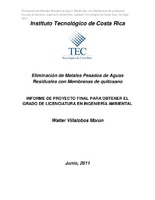Mostrar el registro sencillo del ítem
Eliminación de Metales Pesados de Aguas Residuales con Membranas de quitosano
| dc.contributor.advisor | Mora-Molina, Jesús | es |
| dc.contributor.author | Villalobos-Morún, Walter | |
| dc.date.accessioned | 2015-09-01T17:04:07Z | |
| dc.date.available | 2015-09-01T17:04:07Z | |
| dc.date.issued | 2011 | |
| dc.identifier.uri | https://hdl.handle.net/2238/6264 | |
| dc.description | Proyecto de Graduación (Licenciatura en Ingeniería Ambiental) Instituto Tecnológico de Costa Rica. Escuela de Química, 2011. | es |
| dc.description.abstract | The motivation for this project began in implementing environmentally friendly materials and biodegradable in order to remove heavy metals from wastewater, using a low energy consumption technique of. On the other hand to produce a inexpensive and effective solution and applicable to specific problems, standardizing a new kind of membrane technology in water treatment, the benefit to public health and the environment in order to prevent environmental problems and health by direct and indirect contact with heavy metals. To get to standardize worked Chitosan membranes with different mass-mass concentration (m/m) of Chitosan in the production of membranes and also with variations in the concentration of cross-linking agent of the membranes (glutaraldehyde) to find the optimum point thereof, which responded by producing optimally cross-linked Chitosan membranes. With the completion of this phase, physical and mechanical tests were performed, and also some other measurements, like the membrane thickness, resistance to pressure and stress testing of the membranes in order to help standardize them. Finally, the membranes were used in testing the effectiveness to remove heavy metal ions from waste water, first with standard solutions and / or models prepared in research laboratories (CIPA and CEQIATEC), because the wastewater samples from different industries(tanneries, electrical and paint) effluent had concentrations below the limits of the wastewater discharge canon, this effect was found by atomic absorption analysis of post filtering model solutions of cadmium, copper and chromium prepared in the laboratory. Results were obtained with an efficiency of 23,05% for chromium, 14,10% for cadmium and 16,09% for copper, this for intersecting membranes. On the other hand some membranes without crisscrossing were taken as a control sample, the difference in retention between a membrane cross-linked and one without interbreeding being as 20,52% removal efficiency for chromium, 15,37% for cadmium and 13,63% for copper. In this way it was verified the effectiveness of the membranes in removing heavy metals from wastewater, since the effectiveness of the membranes did not exceed 50%, yet these have deteriorated in a short lifetime, include checking a new application of a natural substance or biopolymers in the environmental field. | es |
| dc.description.sponsorship | Instituto Tecnológico de Costa Rica. Escuela de Química. | es |
| dc.language.iso | es | es |
| dc.publisher | Instituto Tecnológico de Costa Rica | es |
| dc.rights | acceso abierto | es |
| dc.subject | metales pesados | es |
| dc.subject | membranas entrecruzadas | es |
| dc.subject | salud pública y el ambiente | es |
| dc.subject | membranas de quitosano | es |
| dc.title | Eliminación de Metales Pesados de Aguas Residuales con Membranas de quitosano | es |
| dc.type | proyecto fin de carrera | es |


